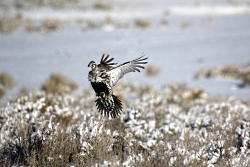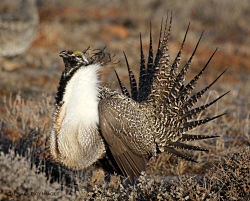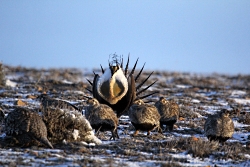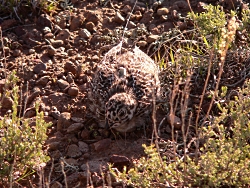
The females are attractive chicken-size birds with gently curved bodies. Their feathers show streaks of black, brown and gray. This pattern acts as a natural camouflage in their sagebrush habitat to help protect them from predators.

To help protect against predators their wing and back feathers have streaks of black, grey, and brown – similar to the females.
Buried under the male’s white breast feathers are two air sacs that remain concealed until mating season begins.
The greater sage-grouse are probably best known, by most, for their extravagant courtship rituals.
Around the beginning of March, the male grouse return to their communal mating grounds called a lek where they compete with other males to attract and breed with the females. The ritual is called lekking. The lek is in an open area where visibility is good – such as a dry lakebed.

The females are attracted to the leks by the calls of the males, which can carry for over 1.5 miles. When they arrive, they roost among the males to watch their strutting performances. The hens may visit the lek several times during the breeding season before nesting.
During the courtship rituals, the females will begin searching for a nesting site. Most will choose to build their nests under the protective cover of a sagebrush bush. The female lines the bowl-shaped nest with dead grass and a few feathers. When she sits on her nest of 6-8 eggs, her camouflage colors go to work and make her nearly invisible from her surroundings. A potential predator may often pass by her as she sits motionless and in silence on her nest for a 30-day incubation period.

Biologists estimate that since the European settlement of North America there has been a 50% decline of the sage-grouse sagebrush habitat and population.
In the late 1990’s, in an effort to reverse this trend, Messmer through Utah State University entered into a collaboration with the State of Utah and numerous other stakeholders to develop a community-based conservation plan. Its purpose was to bring local communities, agencies, and researchers together to determine the best methods to preserve sage-grouse, their sagebrush habitats, and benefit the local community – without having to list it for protection under the federal Endangered Species Act.
After two decades of hard work, the partners have witnessed a resurgence of the greater sage-grouse as their habitats have been protected, enhanced and expanded.
If you’d like to see greater sage-grouse, the largest populations are found in western Box Elder County, on Blue and Diamond Mountains in Uintah County in northeastern Utah, in Rich County, and on Parker Mountain in south central Utah. Just remember to bring your binoculars.
This is Shauna Leavitt for Wild About Utah.
Credits:
Photos: All photos courtesy of and used with permission of Todd A. Black.
Text: Shauna Leavitt, Utah Cooperative Fish and Wildlife Research Unit, Quinney College of Natural Resources, Utah State University
Additional Reading
To learn more about Utah sage-grouse conservation, please go to www.utahcbcp.org.
